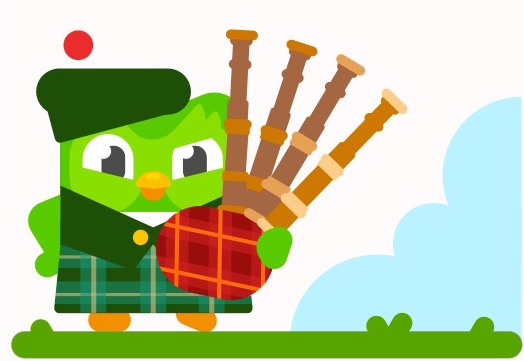“Gaelic is Here!”
A great thing happened last week. After weeks of waiting (which is actually much earlier than first announced) Scottish Gaelic was added to Duolingo.
For those of you who are not familiar, Duolingo is a language app launched in 2011 that offers more than 90 language courses on iOS and Android devices as well as its website. The languages offered range from European staples like English, French, Spanish to Chinese, Japanese and Korean. But the options also offer courses in some endangered languages such as Gaelic, Hawaiian and Navajo as well as recently constructed languages like Klingon (Star Trek) and High Valyrian (Game of Thrones).
I had dabbled in Duolingo before touching up on my Latin and Klingon but didn’t progress too far with either. When Scottish Gaelic was first announced, I was one of the 20,000 people who had signed up for the Scottish Gaelic course ahead of its release, initially projected for summer of 2020. Developers say that now, in just the first week of its release, more than 65,000 have begun the course. For comparison, the last UK census in 2011, 57,375 respondents claimed Scottish Gaelic as a language. With efforts for Gaelic education in Scottish schools, that number has surely risen, but its still a good start for only a week after release on Duolingo. (As a caveat, I realize that these 65,000 learners with a week’s experience and a less than 200 word vocabulary have nowhere near the level of understanding of the language as the 57,000+ speakers who were confident enough of their ability to list it as a second language on a census report.)
On Duolingo, users learn a language by playing various games including typing words or phrases, matching grammar and also speaking or listening to sentences (although speaking is not yet a part of Scottish Gaelic). Users earn “crowns” and “lingots” as they progress their knowledge through a number of levels and also can compare their progress to that of other learners on leaderboards. Personally, I’m happy that in my fist week I’ve earned several achievements including one for learning 175 words (although I couldn’t tell you all of them) and for coming in first place on my weekly leaderboard.
As effective as it is, Duolingo is not perfect. The “gamification” of the process helps make the lessons addictive (over the past week I spent my spare time learning on Duolingo in lieu of playing games on my phone, rather than in addition to playing them) and less like learning. However, from a learning standpoint, there are some drawbacks. First, the dictionary feature at the Duolingo website is not available on the iOS app, and I would assume that most users are accessing Duolingo on their phones. The website is not perfect either, as adding the grave marks to vowels (à, è, ì, ò, ù) which is relatively easy on my phone’s touch keyboard can be cumbersome to add from the desktop keyboard – this is significant because missing a mark can mean getting a word wrong.
Perhaps the most challenging part it the lack of instruction on conjugations and lenitions. Conjugations are the varied forms verb take depending on the person (example: to be = I am, you are, it is). Lenition is the weakening of a consonant sound that happens rarely in English (such as the difference in the “t” sound in “maternal” and “mother” two English words which both descend from the Latin “mater”). However, in Gaelic lenition happens frequently and it can take a while to learn that “balach” and “bhalaich” (pronounced “valach”) are the same word meaning “boy.”
Now, I get that Duolingo takes the approach of teaching us as a child would learn – making users deduce the rules from repeated context – but some of us would just like to see these rules in advance, you know like those pages full of verb conjugation charts I remember from Wheelock’s Latin Grammar.
Despite these minor inconveniences, I am still learning Scottish Gaelic in an easily accessible format. In time, this effort will get me to a level where I would feel confident in investing the money into an online Gaelic course should I decide to pursue the language further. But for now, free and easy is good!
To find out more or to try Gaelic or any of their other language offerings yourself, visit duolingo.com or download the duolingo app on your iOS or Android device.
